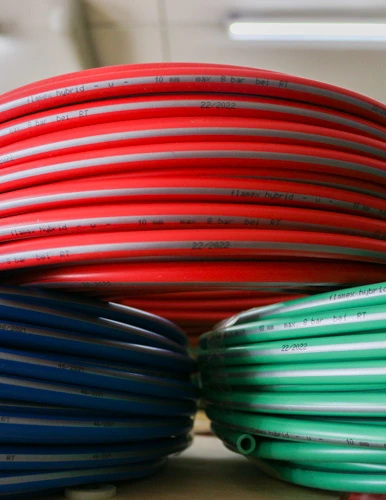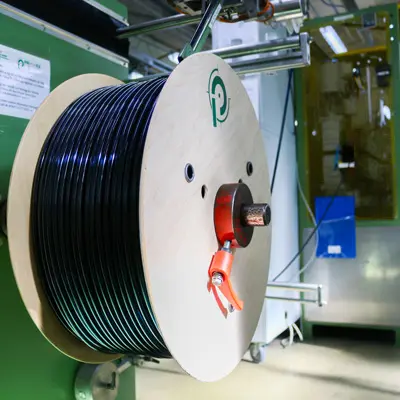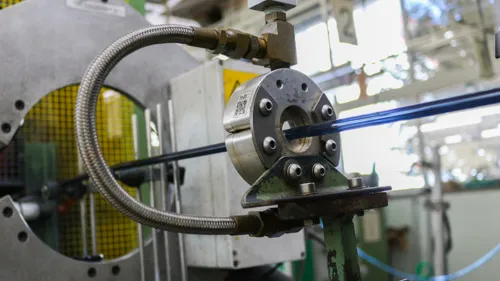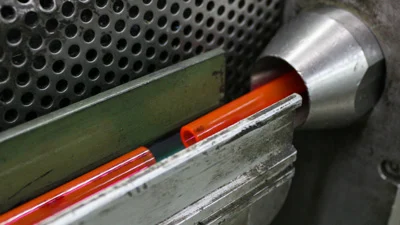Pneumatic tubing: How to find the right one for your purpose.
Applications, materials, requirementsPneumatic tubing
Pneumatic tubing is often seen as a low-tech component. However, tubing fulfills very important tasks in many cases. Additionally, it has to work in a variety of different circumstances. This article is a deep dive into the applications, requirements and materials of pneumatic tubing with the following contents:

Pneumatics – what does that even mean?
Before the different facets of usage are discussed, the term pneumatics needs to be defined.In order to understand what the requirements for pneumatic tubing are, it is important to know what pneumatics is and where it gets used.

Definition and usage
Pneumatic generally describes the usage of compressed air to fulfill work. Accordingly, the term has its roots in the ancient Greek name “Pneuma” for wind or breeze.
Pneumatic applications compress surrounding air to use it for foreseen purposes. In most cases, the working pressures range from 6 to 40 bar (87 to 580 psi). After the air is compressed, it has to get cleaned from impurities. This happens via the filters. After that, the air is ready for the planned application.
A challenge of pneumatics is the allocation of compressed air to the foreseen consumer points. Here, pneumatic tubing comes into play. The latter has to be leakproof and free of impurities. Otherwise, the longevity and functionality of the whole system are threatened.
Probably the most widespread application for pneumatics is pneumatic drives. The latter use compressed air cylinders to execute linear movements. A simple example of that is tools like air hammers. Pneumatics gets used for atomizing liquids while spraying as well. Moreover, compressed air facilitates transport applications like tube mail. The application areas are extremely versatile and exceed the mentioned examples by far.
Advantages and disadvantages of pneumatics
To begin with the advantages:
Pneumatics is applicable anywhere: Air is easily available in most environments. Additionally, no hazardous substances arise during the application so that the used air can be released without processing. Moreover, the generated pressure is relatively easy to save and transfer to the foreseen application points.
Pneumatics is clean: If a hydraulic line has a leakage, fluids inevitably leak out. In many areas that require absolute cleanness, that can become a problem quickly. A leakage in a pneumatic tubing or one of the connecting points is not delightful either, but the only thing that can leak out is air. Impurities are not an additional problem in most cases here.
Pneumatics is very safe: Generally, many parts of pneumatic systems such as compressors, pistons or pneumatic tubing are very low in wear and tear. Hence, failures are pretty rare within these systems. Moreover, the usage of air holds far fewer dangers compared to oil or other liquids. Thus, pneumatics can be used in very sensitive areas, in which fire and explosion hazards are present.
Naturally, pneumatic systems do have disadvantages as well:
Limited loading capacity: Pneumatic systems are robust and resilient. However, the pressures have their preset limits. The higher the working pressure of a system is, the greater the effort to secure the whole application.
Partly loud application: During the usage of compressed air systems, noise usually occurs. Through the release of air, turbulences arise. These can lead to loud noises in return. To a certain degree, the noise can be reduced by the usage of silencers.
Low efficiency: One of the main points of criticism with pneumatic systems is the relatively low efficiency. During the compression of air, energy gets lost as heat. However, the losses can be reduced by the re-usage of that waste heat.

Requirements for pneumatic tubing
The variety of different pneumatic tubing is immense. Which of them is the best, can’t be said in general terms – it depends largely on the requirements of the specific use case. Nevertheless, different materials and material mixtures make it possible to find the right fit in almost any case.
Pressure resistance
A requirement any pneumatic tubing has to fulfill is a certain pressure resistance. Here, the wall thickness and the hardness of the used material play a large role. The tubing with the highest pressure resistance is not always the best. You might want to know the minimum you can go with, and here is why:
- The thicker the wall, the more expensive the tubing becomes. To produce thicker walls, more material is necessary, and that makes a large portion of a tubing’s price.
- The harder the material, the less flexible it is. For instance, polyamide tubing can generally withstand greater pressures than polyurethane tubing. However, it needs way more space for the installation due to its larger minimum bending radii. Furthermore, in many cases, softeners are necessary to make the material usable.
–>Read our article on the comparison between polyamide and polyurethane
For these reasons, it is important to know which pressures a tubing has to withstand. Shooting too high might become expensive and uncomfortable during the installation. However, the requirements for pneumatic tubing are much more versatile in many scenarios.
Bending radii (Flexibility)
Despite all their resilience and robustness, pneumatic tubing still has to be flexible. Otherwise, a simple pipe could be applied in many cases instead. To be able to compare the flexibility of different tubes, in practice the bending radius gets used as a key figure. It indicates which is the smallest possible radius the tubing can get bent without kinking or taking any damage. The smaller the minimum bending radius, the higher the flexibility of the tubing. The diameter and the wall thickness of the tubing have a large impact on the minimum bending radius. To put it in a nutshell, finding the best pneumatic tubing for any use case is always a compromise between pressure resistance and flexibility.
In application areas where especially small bending radii are required, it is advisable to install kink-proof pneumatic tubing. This special product has an inner profile that prevents kinking and secures flow, no matter how small the bending radius might be. Thus, the kink-proof tubing can be installed in minimal space without threatening the function of the system.

Resilience against environmental influences
Not all applications for pneumatic tubing are inside or under easy conditions. They get used outdoors as well, in agricultural technology for example. Consequently, the tubing has to withstand all environmental influences that can occur during these applications. Polyamide tubing is quite robust and resistant to most fluids and chemicals imaginable in this scenario. But there are more flexible alternatives made of polyurethane as well. For instance, polyether-polyurethane is resistant to hydrolysis and microbes. Based on that material, there is a polyurethane pneumatic tubing built especially for the application in agricultural technology.
Abrasion resistance
In many application areas for pneumatic tubing, resilience against abrasion is of high importance. If they get used as a conveying connection for food or beverages, abrasion has to be as small as possible because nobody wants to have residuals in their food. For this use case, polyether polyurethane is a good choice again. But there are even harder circumstances for the tubes. Many of them are used with drag chains. Therefore, excellent abrasion resistance in combination with good recovery properties is key. Once again, the high-quality material polyurethane might be the right choice for this purpose.
Special requirements
There is suitable pneumatic tubing for almost any special requirement. For example, flame retardant tubing is crucial for several industries where weld splatter and sparks are omnipresent. Other fields like the railway industry or aircraft manufacturing have special norms which regulate the burning behavior of all used materials. For instance, this pneumatic tubing is compliant with the EN 45545 norm which is of high importance in the railway industry.
Moreover, application scenarios with a high risk of explosion require special components. In most of them, it is crucial to avoid static charging. Of course, there is an antistatic tube that fits this purpose perfectly. Another use case for antistatic tubing is the manufacturing of sensitive electronic components.
The food industry is a further field with very special demands for the used components. It is very difficult to keep an overview of the regulation jungle of the food industry. But there is pneumatic tubing suitable for food contact as well. In some cases, additional examinations might be necessary.
The different forms of pneumatic tubing
Usually, tubing is traded as so-called “meter goods”. This term means that the tubing is supplied in coils or wound on reels. The standard is lengths between 25 and 50 meters in the case of coils. Reels are usually used for lengths from 100 meters and more.
Pneumatic tubing is available in shorter lengths as well. This is particularly useful if the tubing shall be mounted in the exact same length again and again. Cut-to-size tubing saves a lot of time for the end user because it does not need to be cut again before the application.
Besides meter goods and cut-to-size, pneumatic tubing is also available in the form of spirals. Tube spirals are predestined for usage at work stations where certain movement flexibility is necessary. The spiral form has the advantage, that it is not in the way if the user does not demand the full work length. On the other hand, the full work length can be used at any time without additional effort.
The last form of pneumatic tubing mentioned here is multi tubes. Multi tubes are several combined lines. Duo, Trio, Quattro tubing, or even more combined lines are technologically possible. The advantage of multi tubes is that several lines can get installed in a single step. Furthermore, a variety of media can get conveyed simultaneously with that single installation.

Besides meter goods and cut-to-size, pneumatic tubing is also available in the form of spirals. Tube spirals are predestined for usage at work stations where certain movement flexibility is necessary. The spiral form has the advantage, that it is not in the way if the user does not demand the full work length. On the other hand, the full work length can be used at any time without additional effort.
The last form of pneumatic tubing mentioned here is multi tubes. Multi tubes are several combined lines. Duo, Trio, Quattro tubing, or even more combined lines are technologically possible. The advantage of multi tubes is that several lines can get installed in a single step. Furthermore, a variety of media can get conveyed simultaneously with that single installation.
Pneumatic tubing – individualization possibilities
Pneumatic tubing can get highly individualized to meet the requirements of the usage purpose perfectly. There are several possibilities for individualization.
The color
It sounds banal at first, but the color of tubing can lead to very useful simplifications. However, the colors of pneumatic tubing do not have a predefined meaning. The meaning can get defined individually by the user instead. For instance, if several lines have to get mounted on a machine, it is very useful to work with color codes. Thus, it can be ensured at any point of the lines which tube is plugged in at what port. But this is only one example of the importance of the meaning of pneumatic tubing. Of course, the color can be selected to be as inconspicuous as possible at a machine, for example matching the color of the user company. The color selection has hardly any boundaries.
Printing
Another possibility to set individual accents is the printing of pneumatic tubing. Starting with the branding via the company logo, over the printing of the internet address, to the signature with manufacturing marks, many things are possible. Like the color, the printing can help to deviate different tube lines. It is needless to say that printing can be used simply to look good as well.
However, before printing on a pneumatic tubing, a few things have to be checked. Does the tubing have contact with water? Is it supposed to be used with food contact? Accordingly, it is necessary to clarify if the printing is suitable for the planned usage in the first place. Laser printing, offset printing or inkjet printing cover a broad range of applications.
Summary: How to find the right pneumatic tubing?
Tubing is easily bought, but how to find the right one? Pneumatics is a very versatile field. In general, it describes the usage of compressed air to fulfill work. Due to the good availability of air, its cleanness, and safety, pneumatics can be used nearly anywhere.

Pneumatic tubing is available in many different variations. To find the best one for the purpose, the right mixture of the main characteristics has to be found. Therefore, the following questions should be answered beforehand:
- Which pressures does the pneumatic tubing have to withstand?
- How much space is available to install the pneumatic tubing?
- Is the pneumatic tubing exposed to any environmental influences?
- Which media does the pneumatic tubing come in contact with?
- Are there norms or regulations the pneumatic tubing has to comply with?
If these questions can be answered, the journey to the optimal pneumatic tubing is not far anymore. To set the theory into practice, just ask your favorite manufacturer!
Any questions?
Don’t hesitate to give us a call – we are happy to advise you.

